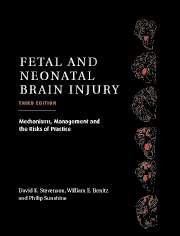Book contents
- Frontmatter
- Contents
- List of contributors
- Foreword
- Preface
- Part I Epidemiology, Pathophysiology, and Pathogenesis of Fetal and Neonatal Brain Injury
- Part II Pregnancy, Labor, and Delivery Complications Causing Brain Injury
- 9 Maternal diseases that affect fetal development
- 10 Antepartum evaluation of fetal well-being
- 11 Intrapartum evaluation of the fetus
- 12 Obstetrical conditions and practices that affect the fetus and newborn
- 13 Fetal and neonatal injury as a consequence of maternal substance abuse
- 14 Chorioamnionitis and its possible relation to subsequent cerebral palsy
- 15 Bacterial sepsis in the neonate
- 16 Neonatal bacterial meningitis
- 17 Neurological sequelae of congenital perinatal infection
- 18 Perinatal human immunodeficiency virus infection
- 19 Inborn errors of metabolism with features of hypoxic–ischemic encephalopathy
- Part III Diagnosis of the Infant with Asphyxia
- Part IV Specific Conditions Associated with Fetal and Neonatal Brain Injury
- Part V Management of the Depressed or Neurologically Dysfunctional Neonate
- Part VI Assessing the Outcome of the Asphyxiated Infant
- Index
- Plate section
14 - Chorioamnionitis and its possible relation to subsequent cerebral palsy
from Part II - Pregnancy, Labor, and Delivery Complications Causing Brain Injury
Published online by Cambridge University Press: 10 November 2010
- Frontmatter
- Contents
- List of contributors
- Foreword
- Preface
- Part I Epidemiology, Pathophysiology, and Pathogenesis of Fetal and Neonatal Brain Injury
- Part II Pregnancy, Labor, and Delivery Complications Causing Brain Injury
- 9 Maternal diseases that affect fetal development
- 10 Antepartum evaluation of fetal well-being
- 11 Intrapartum evaluation of the fetus
- 12 Obstetrical conditions and practices that affect the fetus and newborn
- 13 Fetal and neonatal injury as a consequence of maternal substance abuse
- 14 Chorioamnionitis and its possible relation to subsequent cerebral palsy
- 15 Bacterial sepsis in the neonate
- 16 Neonatal bacterial meningitis
- 17 Neurological sequelae of congenital perinatal infection
- 18 Perinatal human immunodeficiency virus infection
- 19 Inborn errors of metabolism with features of hypoxic–ischemic encephalopathy
- Part III Diagnosis of the Infant with Asphyxia
- Part IV Specific Conditions Associated with Fetal and Neonatal Brain Injury
- Part V Management of the Depressed or Neurologically Dysfunctional Neonate
- Part VI Assessing the Outcome of the Asphyxiated Infant
- Index
- Plate section
Summary
Clinical chorioamnionitis is a primary infection that involves the chorioamniotic membranes and the intraamniotic cavity. Microscopically, clinical chorioamnionitis is defined by bacteria and leukocytes that are found between the chorion and the amnion, and by isolation of bacteria from the amniotic fluid. Other terms used in the literature are intraamniotic infection, amnionitis, amniotic fluid infection, intrauterine infection, and intrapartum infection. However, clinical chorioamnionitis is distinct from histological chorioamnionitis, which is defined by the infiltration of polymorphonuclear cells into the placenta and choriamniotic membranes.
The clinical manifestations of chorioamnionitis include fever, maternal and fetal tachycardia, uterine tenderness, foul odor of the amniotic fluid, and leukocytosis. Although a combination of these signs may be present in most women with chorioamnionitis, they are by no means universal. Recent studies are usually based on the clinical criteria defined by Gibbs and Duff which include maternal fever of 37.8°C or greater as a mandatory sign, plus two or more minor signs (maternal tachycardia >100 beats/min, fetal tachycardia >160 beats/min, uterine tenderness, foul odor of the amniotic fluid and leukocytosis >15000/mm3).
Fever accompanies virtually all cases of clinical chorioamnionitis. The criteria that define maternal and fetal tachycardia exceed the 90th percentile and are discovered in a wide range (20–80%) of patients with intraamniotic infection. Leukocytosis can be a normal finding in women during labor without obvious signs of infection. The mean intrapartum white blood cell count is 12500±3900/mm3 and increases in linear fashion with an extending duration of labor.
- Type
- Chapter
- Information
- Fetal and Neonatal Brain InjuryMechanisms, Management and the Risks of Practice, pp. 303 - 313Publisher: Cambridge University PressPrint publication year: 2003



